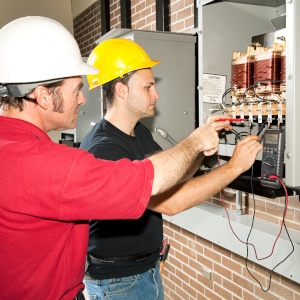Understanding electrical safety in the workplace
|
Electrical hazards present a very serious risk to the life and health of those who work around electricity. In fact, one in every five critical injuries involving electricity results in a fatality. It doesn’t take much electricity to cause injury: less than one amp can result in stopped breathing and contact with only 15 amps may result in death.
What is an Electrical Hazard? Some workers may mistakenly believe that they are not at risk of an electrical injury. On the contrary, while some workers are in lower-risk sectors, all workers are at risk for an electrical injury. Some example of electrical hazards include: |
 |
- Overloaded circuits
- Improper ground
- Electrical cords with broken grounding pins
- Damaged wiring
- Working near power lines
- Failure to lockout energy to machines/equipment while completing maintenance or repairs
- Loose/improper connections
- Frayed electrical cords
- Lack of GFCI near water sources
Everybody is responsible for safety at work - including electrical safety
Role-specific Responsibilities
As always, everybody is responsible for safety at work. And while that’s true, there are also role-specific responsibilities:
Employers
|
Supervisors
|
Workers
Constructors
|
 |
Preventing Electrical Injuries
There are many solutions that employers can put in place to mitigate the risk of an injury resulting from electricity in the workplace. For the most part, good housekeeping and maintenance are key. Cords and plugs should be kept in good condition and discarded if their condition is substandard. Receptacles should be kept clean and free from debris. Faulty wiring should be identified during workplace inspections and repaired. In addition to good housekeeping practices, there are other ways to prevent electrical injuries at work:
When it comes to reducing the risk of injury caused by electricity, training is key. Workers must understand the risks of working with electricity and the procedures for proper lockout. Additionally, workers much understand how electricity functions, so that they can work safely and with appropriate caution when working with or near electrical sources.
- Always lockout live equipment before cleaning or repairing
- Provide and require all necessary PPE when working around electricity
- Use a signal person when work is being conducted near live overhead wires
- Provide training
When it comes to reducing the risk of injury caused by electricity, training is key. Workers must understand the risks of working with electricity and the procedures for proper lockout. Additionally, workers much understand how electricity functions, so that they can work safely and with appropriate caution when working with or near electrical sources.
While some workers are in lower-risk sectors, all workers are at risk for an electrical injury
Trust MidSouthWest Training and Consulting
MidSouthWest Training and Consulting provides Electrical Safety Awareness Training and Lockout training. In light of COVID-19, we also provide electrical safety training and lockout training online, so that workers can still train while physical distancing. You can trust MidSouthWest Training and Consulting to provide you with cost-effective training solutions tailored to meet your organization’s unique health and safety needs.
To learn more, contact us online or call 289.309.1143. Visit us 24/7 on the web at midsouthwest.ca.
To learn more, contact us online or call 289.309.1143. Visit us 24/7 on the web at midsouthwest.ca.
Last updated January 6, 2021




